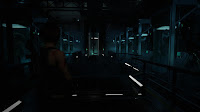I’m having a real hard time trying to decide if I like The Outer Worlds or not. With more than 20 hours played and roughly half of the game completed, I’m still on the the fence, so I thought I’d post my initial impressions and try to figure out exactly why I’m struggling to get through it.
The Outer Worlds is a sci-fi first person RPG. You play as a recently de-thawed colonist in the Halcyon system. It’s a setting that’s clearly had a lot of thought and attention put into it with a wide and varied range of corporations, characters, environments and technology. There’s clearly a Firefly inspired ‘space western’ style to it as you recruit a rag-tag crew of mercenaries and bounce from one frontier world / outpost to the next in search of ever more lucrative work.
The game is very bright and colourful (although arguably a little too garish at times) and takes a rather laid back, not-too-serious approach to its setting, missions, characters and dialogue. And dialogue is a big part of The Outer Worlds, with all of your various speech skills (persuade, lie and intimidate) playing a key role, in addition to various other skills such as medicine, engineering or perception.
I really like the dialogue system and how so many of your skills come into play when interacting with others and opening up new ways to approach or complete missions. As far as the RPG mechanics go in terms of building your character with different skills and perks, I really can’t complain.
When you’re not talking you’re going to be fighting and, once again, I don’t really have too many complaints about the combat system. You have a decent, if somewhat limited, selection of weapons, all of which can be upgraded or modified. The armour / clothing options may not be great, but they do the job. Overall, the combat isn’t anything special but it’s solid and fairly enjoyable.
So I like the setting, the
style, the RPG elements and the combat. So why am I struggling to
like the game as a whole? After a lot of thought and consideration I
think I’ve finally figure it out – as unique and interesting as
the setting may be, I feel like I’ve done this all before.
The missions in The Outer World feel so uninspired and by the numbers. I had one quest to find a missing worker who was last seen in a house in some nearby ruins. I entered the house and was immediately confronted by an odd couple who invited me to stay for dinner. Cannibals, obviously. I knew because I’ve played this mission before in so many other games.
And that’s the real problem I’m having with The Outer Worlds. Despite the unique setting, there’s nothing unique about any of the missions you undertake. They all follow the same repetitive patterns from one location to the next, with similar options and outcomes. And they’re not, I hate to say, particularly exciting from a narrative standpoint.
It certainly doesn’t help that The Outer Worlds often splits what should be sub-objectives of a single quest into multiple quests tied to a single location. I find myself having to check my quest log far too often in order to keep up with exactly what quests I’m doing and where so I don’t have to continually backtrack to locations I’ve already visited.
The companion characters who you can recruit also feel very shallow. You only really get to know two of them prior to their recruitment and the rest just kind of join you because . . . well, just because. I’m hoping they’ll become more interesting as I explore their personal side quests but we’ll see how it goes.
For now, I’m going to continue slogging my way through the rest of The Outer Worlds in the hope that it expands and evolves into a more engaging and unique quest experience that actually does justice to the unique and engaging setting. It’s been pretty frustrating so far, I have to say. There’s so many aspects of the game I like, but the entire experience is dragged down by such bland and by the numbers quest design. I really hope it improves.









































